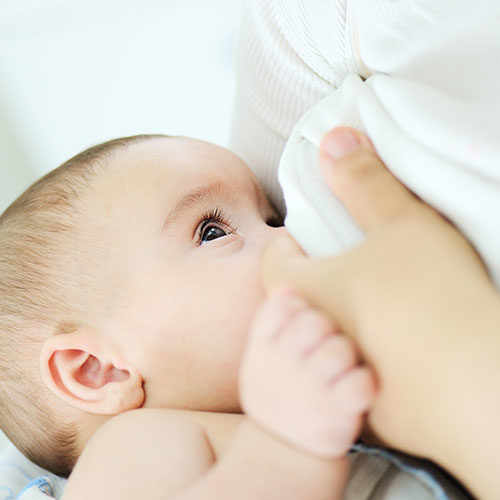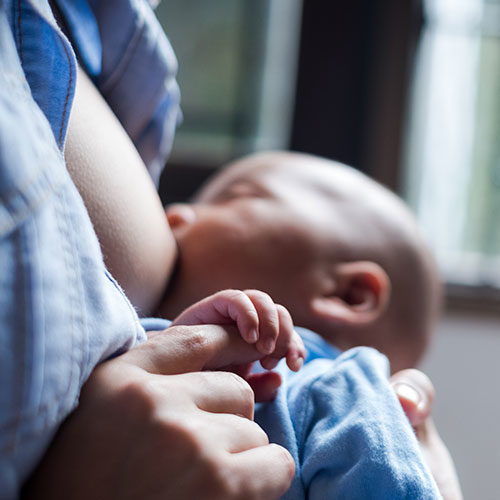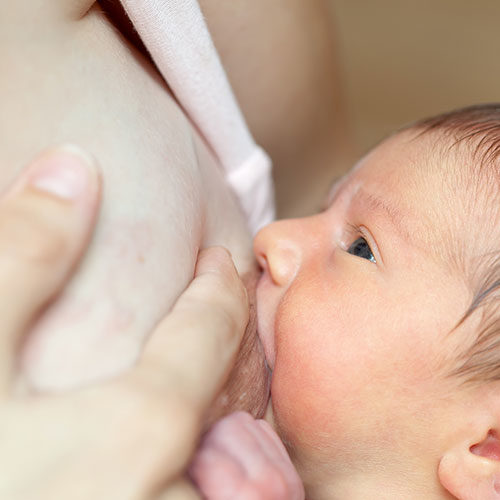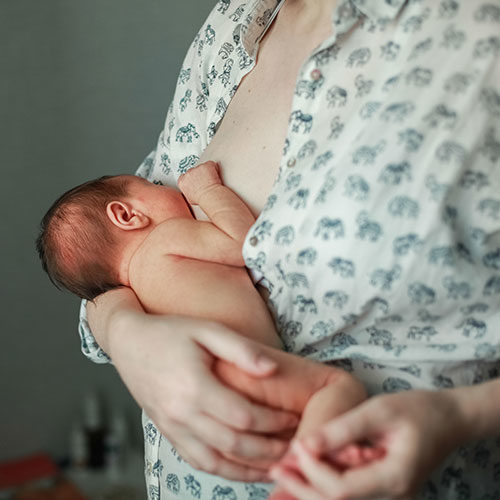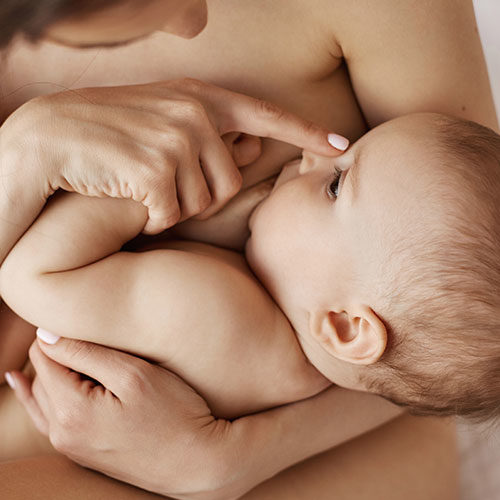Breastfeeding through Teething / Biting
A happily and gently nursing baby suddenly starts chomping down on her mother’s breast. That’s because she is teething!
In most cases, teeth start erupting between 6 and 12 months of age. This phase can be particularly challenging from the breastfeeding point of view as a lot of times, biting accompanies teething, and it can be very painful for the mother. However, it is definitely not the time to wean and there are many ways in which the mother can cope with the situation and continue to breastfeed her baby.
Signs of Teething:
There are some early signs of teething. Some of them are listed below.
- Change in the latch
Every time a baby is teething, her latch needs certain adjustments in order to accommodate the new friend in her mouth. Baby does some trial and error while figuring that out. This process can be somewhat discomforting for the mother.
- Excessive drooling
Babies tend to drool a lot while they are teething.
- Night waking
Teething too is a developmental milestone and around that time, the baby may become fussier and wake up much more frequently at night than usual.
- Biting/chewing on toys and other things
Babies reach the ‘hand to mouth milestone’ around 3 months of age. But while teething, they become more fierce in not just bringing things to their mouth, but even chewing them.
- Loose motion
Some babies pass loose stools while teething. One of the plausible reasons could be that babies instinctively start putting things into their mouths to chew on them. This leads to exposure to a variety of bacteria, some of which may cause a stomach upset.
- Redness on cheeks and low-grade fever
These are relatively less common signs and only a few babies experience them.
Biting explained:
When they are teething, some babies may bite while breastfeeding. This can be very painful for the mother. What is most important to understand here is that – Babies don’t bite when they are actively nursing at the breast. This means that, when the baby is drinking milk, her latch has created a vacuum around the areola and nipple. Her tongue covers her lower jaw, forming a cushion, and the lips are flanged. The mother’s nipple is deep inside the baby’s mouth. She cannot bite at that time. To bite, she needs to break the latch first. This is exactly why biting is most likely to occur either at the beginning of the nursing session (before the baby starts drinking actively) or at the end of the nursing session (after the baby is done). Being vigilant at these times and following certain techniques can help prevent biting.
How to prevent biting?
There are a few techniques that help prevent biting. They can be classified into 3 categories as given below.
Before Nursing | During Nursing | If the baby bites |
Massage the baby’s gums with a clean finger to comfort her. | Be vigilant and observe the baby’s jaws. This will provide an insight into when the baby stops actively nursing. That’s when the possibility of biting occurs. | Try not to give a very sudden, loud and/or harsh reaction (like a scream). Some babies may get scared and refuse to latch. It can even provoke a nursing strike. |
Numb baby’s gums by giving a clean, cold washcloth to chew on. | Keep a keen eye on the baby. When the baby starts losing interest in nursing, she will become more playful and fidgety. It can help to unlatch the baby at that time. | Unlatch the baby immediately and give a cold washcloth to bite/chew on, talk to the baby and resume nursing. If the baby bites again, try ways to comfort her other than nursing. |
If the baby gets milk immediately after latching, she might skip biting. This can be tried by getting the letdown reflex triggered before the baby latches – by massaging the breasts. | Remind the baby that they are not supposed to bite. Decide a word or term to tell the baby every time, e.g. “no biting” or “no ouchie” or any other term in any preferred language. | If the baby continues to clamp down on the nipple, pull the baby toward you so that the baby’s nose is buried in the breast. The baby will automatically open her mouth to breathe and will let go of the breast. |
Additional Tips:
- Talk to the baby –
Babies are often underestimated when it comes to their understanding and comprehending skills. It is very important to talk to the baby about how biting hurts her mom, and she does not like the pain. It should be communicated to the baby gently, but firmly and persistently for the baby to understand. Reiterating this several times a day and especially around nursing can help a great deal.
- Avoid artificial teats like bottles and pacifiers –
When the baby drinks milk from a bottle or when she is given a pacifier, she might bite or chew on its teat. But the bottle or pacifier is not going to resist. And the mother would, when the baby bites while breastfeeding. This could send mixed signals and confuse the child. So, it is better to avoid artificial teats altogether during this time.
Healing Biting Injuries:
A lot of times, in spite of trying many techniques, the baby still might bite. A biting injury can be painful and takes time to heal depending on its severity.
Small and shallow injuries may cause sore nipples and redness. Trying different nursing positions in each nursing session can help the baby’s teeth set at a different angle each time; preventing the trauma on the same spot every now and then. Applying your own milk to the nipple helps in healing faster.
Sometimes a bite can cause a deep cut/injury. The outer layer of the skin may come off. And it can seem next to impossible to nurse from the injured breast. In such cases, the mother needs to give rest to the injured breast to heal. Depending on the severity, the mother may choose to stop offering the injured side for 24 to 72 hours. Most injuries will heal well within that time span when given complete rest along with milk application. If the injury is very deep and the mother feels that there is a risk of infection, consulting a breastfeeding friendly doctor would be wise. While giving rest to the injured breast, it is important to periodically hand express from that side to prevent engorgement and to keep the supply up. This expressed breast milk can be offered to the baby as an alternative to bottles. After the healing has taken place, the mother can start latching the baby while nursing in different positions so that the baby’s erupting teeth will not be at the place the injury was!
Teethers:
Many babies like it when they are given teethers or toys to chew on. There are many available in the market. Some, even with water in them that can be frozen. However, they aren’t necessary. But if a mother wants to give teethers to her baby, it is important to clean them well every time before offering.
Breast milk Popsicles are a hit among many teething babies.
If the baby is on solids, she can be given food that can be refrigerated – e.g. cold banana sticks, cold unsweetened yoghurt finger sticks etc.
References:
https://www.llli.org/breastfeeding-info/teething/
https://kellymom.com/ages/older-infant/teething/
Wish to speak with a member of our team who is a certified lactation professional and also an experienced breastfeeding mother, click on this link.
Medical Advice Disclaimer
THIS WEBSITE DOES NOT PROVIDE MEDICAL ADVICE.
The information, including but not limited to, text, graphics, images and other material contained on this website are for informational purposes only. No material on this site is intended to be a substitute for professional medical advice, diagnosis or treatment. Always seek the advice of your physician or other qualified health care provider with any questions you may have regarding a medical condition or treatment before undertaking a new health care regimen, and never disregard professional medical advice or delay in seeking it because of something you have read on this website.
Disclaimer
We understand and acknowledge that parents and babies can be of various genders on a spectrum of LGBTQI+. Families come in diverse flavours. However, in our articles, for the sake of simplicity and convenience, we will be referring to the breastfeeding parent as the mother and using the female pronouns- ‘she’ and ‘her’ for babies. Babies can be nourished and nurtured in different ways and while we have used the terms breastfeeding and nursing, we recognize that parents can opt to chest feed or finger feed.
We don’t have conflicts of interest and declare, and we are compliant with the WHO code of marketing of breastmilk substitutes and the IMS act.
In case you find any information on this website that needs to be updated, please write to us at info@bsim.org.in

